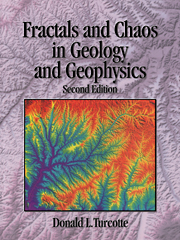Book contents
- Frontmatter
- Contents
- Preface
- Preface to the second edition
- 1 Scale invariance
- 2 Definition of a fractal set
- 3 Fragmentation
- 4 Seismicity and tectonics
- 5 Ore grade and tonnage
- 6 Fractal clustering
- 7 Self-affine fractals
- 8 Geomorphology
- 9 Dynamical systems
- 10 Logistic map
- 11 Slider-block models
- 12 Lorenz equations
- 13 Is mantle convection chaotic?
- 14 Rikitake dynamo
- 15 Renormalization group method
- 16 Self-organized criticality
- 17 Where do we stand?
- References
- Appendix A Glossary of terms
- Appendix B Units and symbols
- Answers to selected problems
- Index
1 - Scale invariance
Published online by Cambridge University Press: 05 June 2012
- Frontmatter
- Contents
- Preface
- Preface to the second edition
- 1 Scale invariance
- 2 Definition of a fractal set
- 3 Fragmentation
- 4 Seismicity and tectonics
- 5 Ore grade and tonnage
- 6 Fractal clustering
- 7 Self-affine fractals
- 8 Geomorphology
- 9 Dynamical systems
- 10 Logistic map
- 11 Slider-block models
- 12 Lorenz equations
- 13 Is mantle convection chaotic?
- 14 Rikitake dynamo
- 15 Renormalization group method
- 16 Self-organized criticality
- 17 Where do we stand?
- References
- Appendix A Glossary of terms
- Appendix B Units and symbols
- Answers to selected problems
- Index
Summary
A stone, when it is examined, will be found a mountain in miniature. The fineness of Nature's work is so great, that, into a single block, a foot or two in diameter, she can compress as many changes of form and structure, on a small scale, as she needs for her mountains on a large one; and, taking moss for forests, and grains of crystal for crags, the surface of a stone, in by far the plurality of instances, is more interesting than the surface of an ordinary hill; more fantastic in form, and incomparably richer in colour – the last quality being most noble in stones of good birth (that is to say, fallen from the crystalline mountain ranges).
J. Ruskin, Modern Painters, Vol. 5, Chapter 18 (1860)The scale invariance of geological phenomena is one of the first concepts taught to a student of geology. It is pointed out that an object that defines the scale, i.e., a coin, a rock hammer, a person, must be included whenever a photograph of a geological feature is taken. Without the scale it is often impossible to determine whether the photograph covers 10 cm or 10 km. For example, self-similar folds occur over this range of scales. Another example would be an aerial photograph of a rocky coastline. Without an object with a characteristic dimension, such as a tree or house, the elevation of the photograph cannot be determined.
- Type
- Chapter
- Information
- Fractals and Chaos in Geology and Geophysics , pp. 1 - 5Publisher: Cambridge University PressPrint publication year: 1997
- 7
- Cited by



